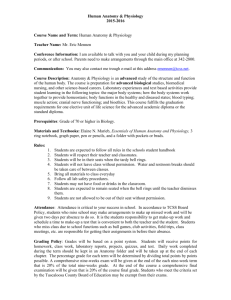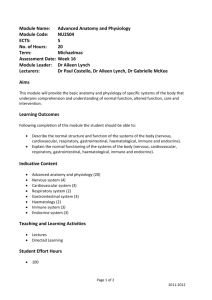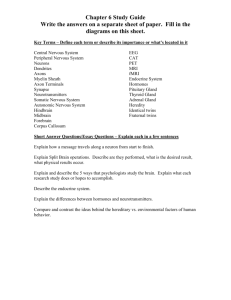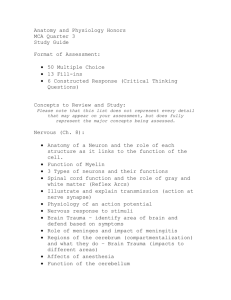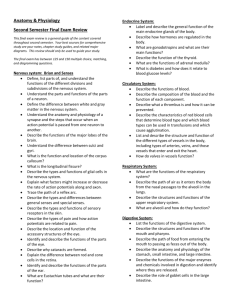BIOL0601 Module 5 Guide G
advertisement
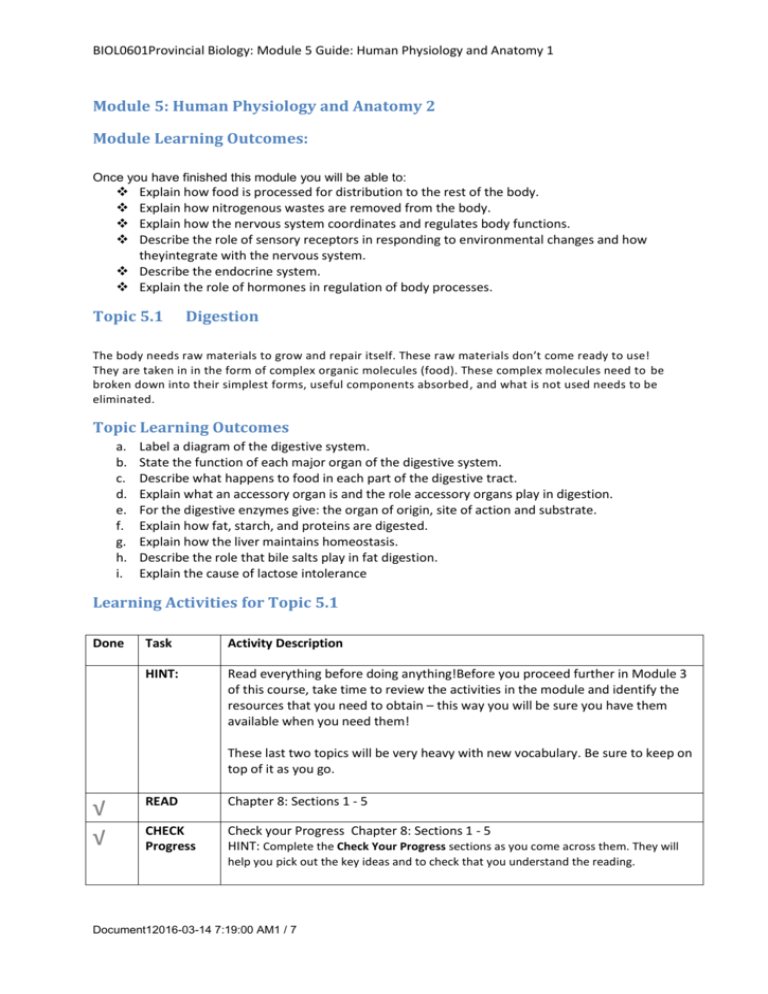
BIOL0601Provincial Biology: Module 5 Guide: Human Physiology and Anatomy 1 Module 5: Human Physiology and Anatomy 2 Module Learning Outcomes: Once you have finished this module you will be able to: Explain how food is processed for distribution to the rest of the body. Explain how nitrogenous wastes are removed from the body. Explain how the nervous system coordinates and regulates body functions. Describe the role of sensory receptors in responding to environmental changes and how theyintegrate with the nervous system. Describe the endocrine system. Explain the role of hormones in regulation of body processes. Topic 5.1 Digestion The body needs raw materials to grow and repair itself. These raw materials don’t come ready to use! They are taken in in the form of complex organic molecules (food). These complex molecules need to be broken down into their simplest forms, useful components absorbed, and what is not used needs to be eliminated. Topic Learning Outcomes a. b. c. d. e. f. g. h. i. Label a diagram of the digestive system. State the function of each major organ of the digestive system. Describe what happens to food in each part of the digestive tract. Explain what an accessory organ is and the role accessory organs play in digestion. For the digestive enzymes give: the organ of origin, site of action and substrate. Explain how fat, starch, and proteins are digested. Explain how the liver maintains homeostasis. Describe the role that bile salts play in fat digestion. Explain the cause of lactose intolerance Learning Activities for Topic 5.1 Done Task Activity Description HINT: Read everything before doing anything!Before you proceed further in Module 3 of this course, take time to review the activities in the module and identify the resources that you need to obtain – this way you will be sure you have them available when you need them! These last two topics will be very heavy with new vocabulary. Be sure to keep on top of it as you go. √ √ READ Chapter 8: Sections 1 - 5 CHECK Progress Check your Progress Chapter 8: Sections 1 - 5 HINT: Complete the Check Your Progress sections as you come across them. They will help you pick out the key ideas and to check that you understand the reading. Document12016-03-14 7:19:00 AM1 / 7 BIOL0601Provincial Biology: Module 5 Guide: Human Physiology and Anatomy 1 √ LAB ACTIVITY Lab 5A Digestion Complete the lab by completing the drawings. The lab instructions are to be found at the end of the assignment. The lab will be submitted along with the completed Module 4 Assignment. Review Activities for Topic 5.1 OPTIONAL REVIEW MATERIAL On-Line “CONNECT” If you have an Internet connection, you can use "Connect". These extra pictures, video Clips and activities are provided by the textbook publisher. They are not required for the course, but they can be very interesting. The URL for the site is: http://highered.mcgraw-hill.com/sites/0073525464/student_view0/index.html If this link is not clickable, copy and paste it into your browser address bar. Connect resources include practice tests, animations and videos, pictures, PowerPoint slides of the illustrations from the text and flashcards. Read over "Summarizing the Concepts" for the chapter/sections covered. It is useful to help you focus on the important concepts covered in the Topic. The Key Concepts section highlights the important ideas/concepts from the chapter. Be sure you can define each and understand its importance. Be careful to watch your time. Connect should only be looked at once you have done the required learning activities. √ REVIEW You should be able to define or describe these key concepts: √ VOCABULARY √ SELF TEST Topic 5.2 The digestion of food is a mechanical and chemical process. The chemical environment of the digestive system is adjusted to accommodate the particular chemical process taking place (enzymes and substrates). Nutrients must be moved into the blood stream for distribution and waste materials excreted. List new words and allow space for you to write definition in your own words. This glossary of technical terms will be important for you for test and final examination preparation. Do the following questions: Testing Your Knowledge – Chapter 8: 2 – 7, 9 – 16, 17 – 21, 22, 23 - 28 Excretion There are many chemicals carried by the circulatory system. Some are waste materials and some are vital to the proper functioning of the body. The kidney is the organ responsible for dealing with these soluble materials. It eliminates soluble wastes and plays and important homeostatic role in keeping other materials in the blood within certain limits. Topic Learning Outcomes a. Describe the organs of the urinary system. Document12016-03-14 7:19:00 AM2 / 7 BIOL0601Provincial Biology: Module 5 Guide: Human Physiology and Anatomy 1 b. c. d. e. f. Illustrate the path of urine. Explain the structure and function of the kidney. Explain how urine is formed. Label a diagram of a nephron, and describe its function. Explain how the kidneys regulate salt balance, water balance, and pH. Learning Activities for Topic 5.2 Done √ √ Task Activity Description HINT: Read everything before doing anything!Before you proceed further in Module 3 of this course, take time to review the activities in the module and identify the resources that you need to obtain – this way you will be sure you have them available when you need them! READ Chapter10: Sections 1 - 4 CHECK Progress Check your Progress Chapter 10: Sections 1 - 4 HINT: Complete the Check Your Progress sections as you come across them. They will help you pick out the key ideas and to check that you understand the reading. SELF TEST Do the following questions: Testing Your Knowledge – Chapter 10: 1 - 8, 10, 11 26 Review Activities for Topic 5.2 OPTIONAL REVIEW MATERIAL On-Line “CONNECT” If you have an Internet connection, you can use "Connect". These extra pictures, video Clips and activitiesare provided by the textbook publisher. They are not required for the course, but they can be very interesting. The URL for the site is: http://highered.mcgraw-hill.com/sites/0073525464/student_view0/index.html If this link is not clickable, copy and paste it into your browser address bar. Connect resources include practice tests, animations and videos, pictures, PowerPoint slides of the illustrations from the text and flashcards. Read over "Summarizing the Concepts" for the chapter/sections covered. It is useful to help you focus on the important concepts covered in the Topic. The Key Concepts section highlights the important ideas/concepts from the chapter. Be sure you can define each and understand its importance. Be careful to watch your time. Connect should only be looked at once you have done the required learning activities. √ REVIEW You should be able to define or describe these key concepts: Describe the structure of the urinary system. Describe the function of the nephron. Describe the formation of urine. Document12016-03-14 7:19:00 AM3 / 7 BIOL0601Provincial Biology: Module 5 Guide: Human Physiology and Anatomy 1 √ Detail the four functions of the urinary system. VOCABULARY List new words and allow space for you to write definition in your own words. This glossary of technical terms will be important for you for test and final examination preparation. SELF TEST Do the following questions: Testing Your Knowledge – Chapter 4: 1, 2, 4 – 13, 15 – 24, 27 Topic 5.3 The Nervous System and the Senses An organism would be unable to survive if it could not effectively interact with its environment. Finding food and avoiding danger are just two such interactions. In order to do this an organism needs to be able to sense its environment, and then process that information so as to be able to react appropriately. This topic will look at how the nervous system and senses perform this job. Topic Learning Outcomes a. Explain how sensory receptors are classified. b. Explain how sensation occurs. c. Explain the senses of taste, smell, vision, hearing, and equilibrium with respect to thetype of sensory receptor involved, the organ involved, and the type of stimulus detected. d. Describe the types of sensory receptors in skin. e. Label a diagram of a neuron and distinguish among sensory neurons, motor neurons, and interneurons. f. Describe the role of myelin. g. Explain how a nerve impulse is transmitted along an axon. h. Explain the role of neurotransmitters. i. Distinguish between the CNS and the PNS. j. Discuss the role of the brain and the spinal cord. k. Describe a reflex arc. l. Distinguish between the somatic and autonomic nervous systems. m. Briefly describe the overall function of each of the following parts of the brain: cerebrum,cerebral cortex, hypothalamus, thalamus, cerebellum, midbrain, pons and medulla oblongata. Learning Activities for Topic 5.3 Done √ √ Task Activity Description HINT: Read everything before doing anything!Before you proceed further in Module 2 of this course, take time to review the activities in the module and identify the resources that you need to obtain – this way you will be sure you have them available when you need them! READ Chapter 13: Sections 1,2 and 4 Chapter 14: Sections 1 – 6 Check your Progress Chapter 13: Sections 1, 2 and 4 and Chapter 14: Sections 1 – 6 HINT: Complete the Check Your Progress sections as you come across them. They will CHECK Progress help you pick out the key ideas and to check that you understand the reading. Document12016-03-14 7:19:00 AM4 / 7 BIOL0601Provincial Biology: Module 5 Guide: Human Physiology and Anatomy 1 √ LAB ACTIVITY Lab 5B The Senses Review Activities for Topic 4.3 OPTIONAL REVIEW MATERIAL On-Line “”CONNECT” If you have an Internet connection, you can use "Connect". These extra pictures, video Clips and activitiesare provided by the textbook publisher. They are not required for the course, but they can be very interesting. The URL for the site is: http://highered.mcgraw-hill.com/sites/0073525464/student_view0/index.html If this link is not clickable, copy and paste it into your browser address bar. Connect resources include practice tests, animations and videos, pictures, PowerPoint slides of the illustrations from the text and flashcards. Read over "Summarizing the Concepts" for the chapter/sections covered. It is useful to help you focus on the important concepts covered in the Topic. The Key Concepts section highlights the important ideas/concepts from the chapter. Be sure you can define each and understand its importance. Be careful to watch your time. Connect should only be looked at once you have done the required learning activities. √ REVIEW You should be able to define or describe these key concepts: Describe the division between the central nervous system and the peripheral nervous system. Describe the major divisions of the central nervous system. Describe the major divisions of the peripheral nervous system. Describe the relationship between neuron, axon, dendrite, synapse and myelin sheath Describe the human senses and the sensors involved. Label a diagram of the eye. Describe a reflex arc. √ VOCABULARY List new words and allow space for you to write definition in your own words. This glossary of technical terms will be important for you for test and final examination preparation. √ SELF TEST Do the following questions: Testing Your Knowledge – Chapter 13, 1, 2, 5 – 7, 15, 16, 19, 24 – 30; Chapter 14, 2, 3, 7, 8, 14 – 26 Topic 5.4 The Endocrine System Just as a town needs a communication system, so does the body. The nervous system is one way that the various parts of the body communicate, but it involves direct connections. A second, more diffuse system exists – the endocrine system. Communications are accomplished by chemical messengers (hormones), distributed throughout the body by the circulatory system. You will see that this system is ideally suited to the functions that it performs. Document12016-03-14 7:19:00 AM5 / 7 BIOL0601Provincial Biology: Module 5 Guide: Human Physiology and Anatomy 1 Topic Learning Outcomes a. b. c. d. e. f. g. Locate and describe the functions of endocrine glands. Distinguish between an endocrine gland and an exocrine gland. Explain how hormones maintain homeostasis. Explain the role of the hypothalamus. Explain how the effect of hormones is controlled (the feedback mechanism). Describe the organs and the process of the regulation of blood glucose levels. Explain the cause of diabetes. Learning Activities for Topic 5.4 Done Task Activity Description √ READ Chapter 15: Sections 1 - 7 The Infectious Disease Supplement contains very important health information and is good background for anyone planning a career in the Health Sciences. √ CHECK Progress Check your Progress Chapter 15: Sections 1 - 7 HINT: Complete the Check Your Progress sections as you come across them. They will help you pick out the key ideas and to check that you understand the reading. Review Activities for Topic 5.4 OPTIONAL REVIEW MATERIAL On-Line “”CONNECT” If you have an Internet connection, you can use "Connect". These extra pictures, video Clips and activitiesare provided by the textbook publisher. They are not required for the course, but they can be very interesting. The URL for the site is: http://highered.mcgraw-hill.com/sites/0073525464/student_view0/index.html If this link is not clickable, copy and paste it into your browser address bar. Connect resources include practice tests, animations and videos, pictures, PowerPoint slides of the illustrations from the text and flashcards. Read over "Summarizing the Concepts" for the chapter/sections covered. It is useful to help you focus on the important concepts covered in the Topic. The Key Concepts section highlights the important ideas/concepts from the chapter. Be sure you can define each and understand its importance. Be careful to watch your time. Connect should only be looked at once you have done the required learning activities. √ REVIEW You should be able to define or describe these key concepts: Explain the difference between and exocrine gland and an endocrine gland. Describe the relationship between endocrine gland, hormone and target organ. Explain the importance of the pituitary gland to the endocrine system. Describe the process by which blood glucose levels are maintained. Describe the role of the endocrine system in homeostasis. Document12016-03-14 7:19:00 AM6 / 7 BIOL0601Provincial Biology: Module 5 Guide: Human Physiology and Anatomy 1 √ VOCABULARY List new words and allow space for you to write definition in your own words. This glossary of technical terms will be important for you for test and final examination preparation. √ SELF TEST Do the following questions: Testing Your Knowledge – Chapter 15: 3, 4 – 8, 11, 12 – 23, 24 – 28. Submit Assignments ASST 5 Complete Assignment 5 and submit it along with all 2 Lab activities. If you are mailing your papers in be sure that your name and the assignment name appear clearly on your papers. If you are submitting your papers electronically, remember to name your file BIOL0601_assignmentX_first_name_last_name.doc and submit through the Assignments Button. MODULE 5 is COMPLETE! Document12016-03-14 7:19:00 AM7 / 7

